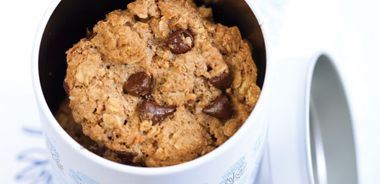Old-Fashioned Oatmeal Cookies

The easiest and most popular dessert to take on a picnic is the ever-portable cookie. And what makes a cookie perfect? Chocolate chips, of course.
1/4 cup (60 mL) unsalted butter, at room temperature
2 Tbsp (30 mL) organic canola oil
1/2 cup (125 mL) organic cane sugar
1/4 cup plus 2 tbsp (90 mL) dark brown sugar, packed
1 large free range egg
1/2 tsp (2 mL) pure vanilla extract
1 cup (250 mL) whole grain cereal flakes
3/4 cup (180 mL) stone-ground whole wheat flour
3/4 cup (180 mL) large flake oats
2 Tbsp (30 mL) ground flaxseed
2 tsp (10 mL) cinnamon
1/4 tsp (1 mL) baking powder
1/4 tsp (1 mL) baking soda
1/4 cup (60 mL) unsweetened flaked coconut
1/4 cup (60 mL) dark chocolate chips
Set rack in your oven to the middle. Preheat oven to 375 F (190 C). Line cookie sheet with parchment paper or grease lightly with oil.
In large bowl, beat butter until fluffy. Beat in canola oil 1 Tbsp (15 mL) at a time until it is well incorporated and butter/oil mixture is fluffy. Add both sugars and beat until fluffy. Add egg and vanilla extract and beat until fluffy.
In medium bowl, mix together cereal flakes, flour, oats, flaxseed, cinnamon, baking powder, and baking soda. Stir in coconut and chocolate chips. Add to butter/sugar mixture. Beat in until cereal flakes are well distributed. If you are using an electric mixer, start off on low and then when incorporated turn up to high.
Drop by heaping tablepoonfuls onto the prepared pan. Lightly press down to flatten.
Bake for 12 to 14 minutes, or until golden brown around the edges. The longer you bake them, the crispier they will get.
Let cool slightly on cookie sheet and then remove to cooling rack; store in airtight container for up to 1 week, or freeze for up to 3 months.
Makes 30 cookies.
One cookie contains:
90 calories; 1 g protein; 4 g total fat (2 g sat. fat, 0 g trans fat); 12 g carbohydrates; 1 g fibre; 19 mg sodium
Tip: These cookies are so delicious, you’ll find them irresistable. But watch your intake of this sweet treat or you’ll quickly overdo it.
Source: "Picnics & Potlucks", alive #344, June 2011




